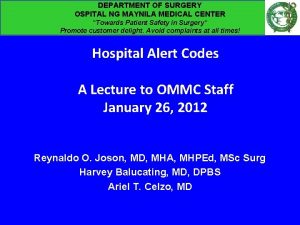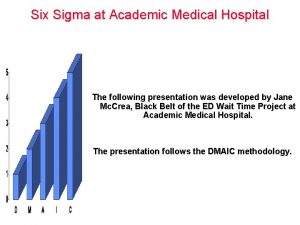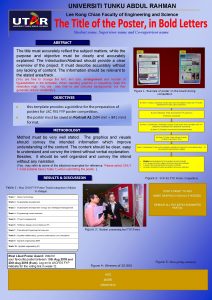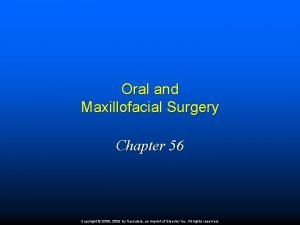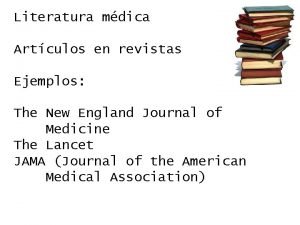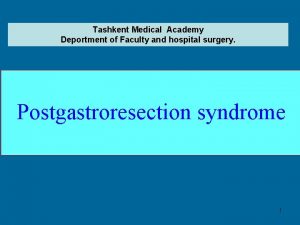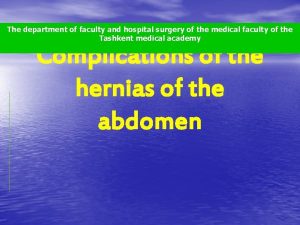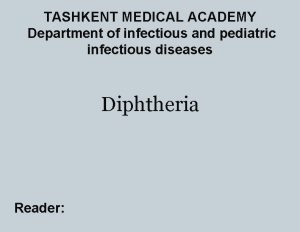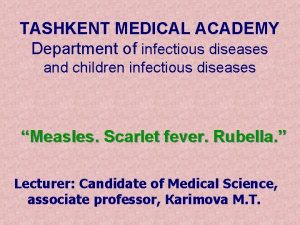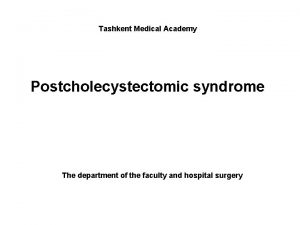Department of faculty and hospital surgery Tashkent Medical












































- Slides: 44

Department of faculty and hospital surgery Tashkent Medical Academy Pleural diseases

The prevalence of pleural diseases n n Empyema refers to the common diseases of the chest. In 30 -50% of cases, it complicates the course of acute and chronic pneumonia, 80 -90% - of gangrene of the lung, in the 9 -15% - lung abscess, 6 -8% - bronchiectasis At 4 -34 patients with acute empyema developed after surgical treatment for lung and pleura. In 1. 3 -3 times more disease in men

With the treatment of diseases of the pleura (empyema) began thoracic surgery. The first description of thoracic surgery belongs to Hippocrates, who diagnosed pleural empyema and cured the sick releasing the pus by a cut (now it's called torakostomiya) Hippocrates (about 460 years BC)

n n Hans Christian Yakobeus (1879 -1937) The clinic as a diagnostic method thoracoscopy was first performed by the Swedish physician, pulmonologist Hans Christian Yakobeusom in 1910 with the help of a cystoscope to diagnose the state of the pleural cavity in patients with tuberculosis. Later Yakobeus designed optical instrument called thoracoscope, whereby initially inspect the pleural cavity, and from 1910 to 1913, he completed 89 of thoracoscopy. In 1913 Yakobeus upgraded Thoracoscope, adjoining the galvanokauter, and began using thoracoscopy for pleural adhesions perezhiganiya. In 1925, he first performed pleural biopsy in patients with mesothelioma and reported on the implementation of 120 thoracoscopy in patients with pulmonary tuberculosis.

In 1925, PA Herzen performed the first in the USSR thoracoscopy in chronic pleural empyema. Subsequently, it is most often used in TB for the intersection of adhesions by galvano-cautery for the formation of a therapeutic pneumothorax. n Peter A. Herzen (1871 -1947)

Sergey Yudin (1891 -1954) Boris Petrovsky (1908 - 2004) Ivan Greeks (1867 -1934) Mikhail Davydov

Vasit Vakhidovich Vahidov Shavkat Ibrahimovic Karimov Sadik Aliyevich Masumov Nikolai Fedorovich Krotov

Duties of the general practitioner in diseases of pleura n n n n n - Provision of primary health and social care; - Health education (promoting healthy lifestyles); - Preventive work (timely detection of early and latent forms of the disease, risk groups); - Dynamic monitoring; - Emergency assistance in case of emergency and acute conditions; - Timely consultation and hospitalization in the prescribed manner; - Medical and rehabilitation work in accordance with the qualifying characteristic; - An examination of temporary disability; - The organization of medical and social care and household together with the bodies of social protection and services of mercy alone, the elderly, the disabled, the chronically ill; - Maintaining the approved forms of records and reports.

Anatomy of the pleura

Anatomy of the parietal pleura 1. Neck part 2. Costal part 3. Mediastinal part 4. Diaphragmatic part

Classification of Diseases of the pleura Empyema 2. Spontaneous pneumothorax 3. Injuries of the chest 4. Clotted hemothorax 5. Fibrothorax 6. Tumor of the pleura 1.

Classification of empyema I. By the origin primary secondary II. The clinical course acute (disease lasts less than 8 weeks) chronic (illness lasts more than 8 weeks) III. By the nature of exudate purulent putrid IV. By the nature of the microflora specific (tuberculosis, fungal) nonspecific (staphylococcal, dyplococcal, anaerobic) mixed V. By the distribution process total and subtotal limited empyema: parietal, basal, interlobarnaya, apical, mediastinal an multi-chamber VI. Iatrogenic empyema

Clinical signs of pleural empyema n n n Cough Sputum Signs of intoxication Fever Asymmetry of chest Auscultation reduction or absence of pulmonary respiration in the affected side

Empyema

Empyema

Empyema radiography computed tomography

Changing the location of the fluid in the pleural cavity according to the position of the patient

Puncture of the pleural cavity


The location of the needle with respect to the fins during the puncture of the pleural cavity

Thoracostomy with the help of the trocar

Technique of chest draining

The valve is used for drainage of the pleural cavity

Device for drainage of the pleural cavity by Byulau

Thoracostomy by Bobrov

Modern plant for active aspiration of the pleural cavity

The scheme of pleuroevacuator

Pleuroevacuator

Methods of rehabilitation of the pleural cavity

Decortication of the lung

As a rule, spontaneous pneumothorax is a complication, not a cause

Spontaneous pneumothorax

Position of the patient on the operating table Intubation tube to separate light

Thoracoscopic intervention in spontaneous pneumothorax Coagulation of the bull Ligation of the bull Suturing of the bull Partial atypical resection Diagnostic thoracoscopy

The advantages of VATS intervention n n n n Reducing trauma surgery Reduction in pain There is no need to find a patient in the intensive care unit Early activation of patients Reducing the number of complications associated with physical inactivity on the part of the surgical wound Reduction in length of hospital stay Reduction in general terms of disability Reducing the flow of drugs and surgical material Good cosmetic effect

Pronounced cosmetic effect after thoracoscopic interventions

Radiographic signs of damage to the chest n n n n n Partial or complete alveolar infiltrates Mediastinal shift Subcutaneous emphysema Pneumomediastinum Fractured ribs Expansion of the shadow of the mediastinum The disappearance of the contour of the aortic arch Mixing of a nasogastric tube to the right Expansion of cardiac contour Presence of gastric bubble and bowel loops in the pleural cavity

Clinical signs of damage at the chest 1. 2. 3. 4. 5. 6. 7. Cyanosis The absence of spontaneous breathing Subcutaneous emphysema The presence of abnormal noise in the pleural cavity The presence of chest injury Bulging neck veins Paradoxical pulse

Hemothorax

Tension pneumothorax Subcutaneous emphysema n For percussion tympanitis on the affected side n Mixing of the trachea in a healthy way n The weakening of the respiratory noise n Unstable hemodynamics n

Open pneumothorax Tension pneumothorax schematic representation of

Treatment of injuries of the chest 1. 2. 3. Thoracostomy Surgical treatment Conservative therapy

Indications for drainage of the pleural cavity 1. 2. 3. Pneumothorax Injuries of the chest Hemothorax

Indications for surgical treatment of injuries of the chest n n n n Cardiac tamponade Large open wound of the chest Signs of damage to the mediastinum Profuse bleeding continues or pleural cavity Massive pnevmoreya on drainage of the pleural cavity Damage to the trachea or main bronchus Rupture diaphragms, aorta, esophagus Foreign body chest
 Tashkent medical academy fee structure
Tashkent medical academy fee structure Tashkent institute of textile and light industry
Tashkent institute of textile and light industry Tashkent university of information technologies
Tashkent university of information technologies Maro tashkan
Maro tashkan Nit calicut chemistry
Nit calicut chemistry Milada cosmetic surgery hospital
Milada cosmetic surgery hospital Ospital ng maynila medical center
Ospital ng maynila medical center Wvu department of surgery
Wvu department of surgery Medical faculty in novi sad dean
Medical faculty in novi sad dean Masaryk university medical faculty
Masaryk university medical faculty Chronic meningitis
Chronic meningitis Hospital pharmacy organization
Hospital pharmacy organization Ninewells hospital and medical school
Ninewells hospital and medical school Medical education and drugs department
Medical education and drugs department Hesf1
Hesf1 Organizational structure of a hospital
Organizational structure of a hospital Flagler hospital billing
Flagler hospital billing Hepburn osteometric board
Hepburn osteometric board Tung shin hospital chinese medical division
Tung shin hospital chinese medical division Kaohsiung medical university hospital
Kaohsiung medical university hospital Six sigma at academic medical hospital case analysis
Six sigma at academic medical hospital case analysis National hospital ambulatory medical care survey
National hospital ambulatory medical care survey Torrance memorial outpatient lab
Torrance memorial outpatient lab Wvmc my chart
Wvmc my chart Importance of medical records
Importance of medical records Doctors license number
Doctors license number Greater baltimore medical center medical records
Greater baltimore medical center medical records Cartersville medical center medical records
Cartersville medical center medical records Mrbs scholarship
Mrbs scholarship Lee kong chian faculty of engineering and science
Lee kong chian faculty of engineering and science Mendel university faculty of business and economics
Mendel university faculty of business and economics Faculty of economics and business debrecen
Faculty of economics and business debrecen Faculty of economics and business zagreb
Faculty of economics and business zagreb Motivated energized and capable faculty
Motivated energized and capable faculty Lee kong chian faculty of engineering and science
Lee kong chian faculty of engineering and science Pubh4401
Pubh4401 Mendel university faculty of business and economics
Mendel university faculty of business and economics Asc code
Asc code Chapter 56 oral and maxillofacial surgery multiple choice
Chapter 56 oral and maxillofacial surgery multiple choice The barbie surgery before and after
The barbie surgery before and after Chapter 26 oral and maxillofacial surgery
Chapter 26 oral and maxillofacial surgery κλειτοριδεκτομή
κλειτοριδεκτομή Gnumed
Gnumed Chapter 56 oral and maxillofacial surgery
Chapter 56 oral and maxillofacial surgery Herszon kherson maritime college of merchant marine fleet
Herszon kherson maritime college of merchant marine fleet






